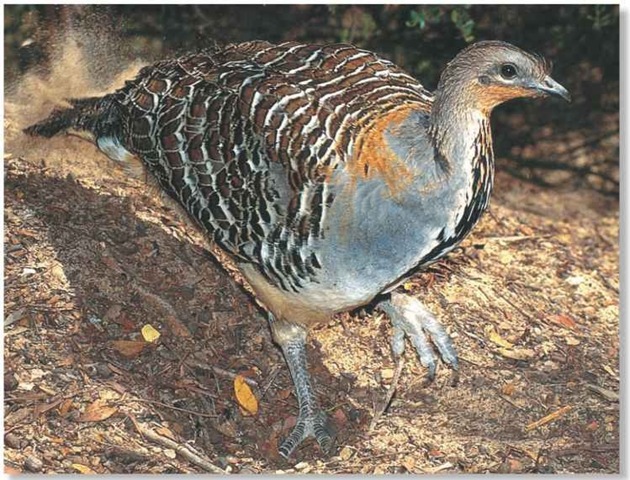ORDER
Galliform.es
FAMILY
Megapodiidae
GENUS & SPECIES
KEY FEATURES
• Builds large mounds of soil and plant matter in which it lays its eggs
• Eggs are incubated using heat generated by rotting matter inside the mound and by the sun’s rays
• Rare across its range; the IUCN (World Conservation Union) classifies it as vulnerable
WHERE IN THE WORLD!
Once distributed over large areas of southern Australia; now restricted to scattered semiarid areas of the southwestern and southern mainland
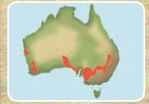
Lifecycle
The hard-working malleefowl faces a life of unremitting toil. Although only a small bird, it builds a huge nesting mound and spends up to 11 months of the year tending it.
Habitat

A Moving mountains The mound may be up to 17′ in diameter and 5′ high.
The malleefowl needs a reliable food supply of seeds and fresh young shoots. It finds this in the vast expanse of semiarid land
in southern Australia.This region encompasses areas where mallee (a dwarf eucalyptus) and acacia are abundant.
Preferring open areas at ground level, the malleefowl looks for territory with shrubby undergrowth nearby in which to find food, and an almost complete canopy above to shield it from the sun.
If an adult malleefowl comes across an emerging chick when tending the mound, it simply kicks the chick out as if it were an item of mound material.
The malleefowl may move up to 300 tons of soil a year regulating the mound’s temperature; 35 cu. feet may be added or removed at a time.
Breeding
The malleefowl uses heat, generated by sun and decomposition of buried vegetation within its mound, to incubate its eggs. The male begins building the mound in early winter, digging a hole 10-13′ in diameter and 3′ deep, then filling it with vegetation.
In early spring, once rain wets the vegetable matter and begins the decomposition process, the birds dig a chamber into which the female lays her eggs. The parent birds then cover the whole mound with sandy soil. Throughout incubation the birds add or remove soil to maintain an ideal temperature of 9I°F.
Upon hatching, each chick digs to the surface where it must fend for itself. It can fly almost immediately.
Birthday suit The hatchling already has camouflaging plumage.
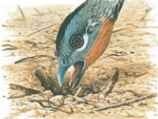
Thermometer bird…
Using heat-sensitive areas in its mouth, the malleefowl tests the mound’s temperature, which should be about 91°F.
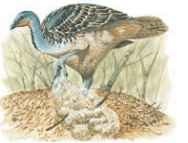
When the going gets hot…
If the mound feels too warm, the mal-leefowl scrapes away some of the soil and vegetation to let the excess heat escape.
Food & feeding

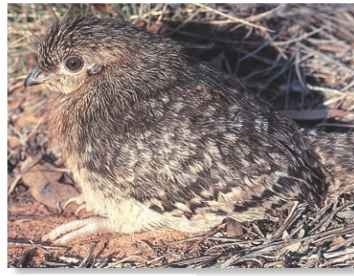
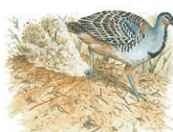
Chilled out…
The malleefowl replaces mound material once the temperature reaches the correct level. The male does the majority of the digging.
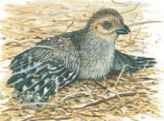
Breakthrough
After hatching, a chick digs through 3′ of soil to reach the surface, a feat that leaves it exhausted for several hours.
The adult malleefowl eats a variety of plant matter including seeds, buds, flowers, leaves and fruit. It typically searches for food by walking slowly along the woodland floor, scratching among leaf litter and in the soil with its powerful feet. Without actively seeking them, the malleefowl also eats any invertebrates and insects that it finds, inadvertently picking them up while foraging.
The young chick feeds almost entirely on invertebrates at first; they are readily available and more easily converted into energy and muscle than plant matter. It gives the chick the best possible start in life — which is vital since it has to fend for itself as soon as it leaves the mound. As it matures, the young malleefowl eats
a-greater proportion of plant matter until, as an adult, its diet consists mostly of tender young shoots and seeds.
Surrounded by food The malleefowl often eats sand to grind down food.
Behavior
Although the malleefowl mates for life, the male and female are solitary and are seldom seen together away from the mound.The male tends the mound every hour, and so forages, sunbathes and roosts close to it.The female, however, wanders across the pair’s range in search of food to sustain her heavy egg production; she visits only for short periods.
The malleefowl’s range varies from 0.4-1.6 sq. miles. It is smaller in rainy areas due to greater densities of malleefowl.
Top of the heap Old mounds are often reused in later years.
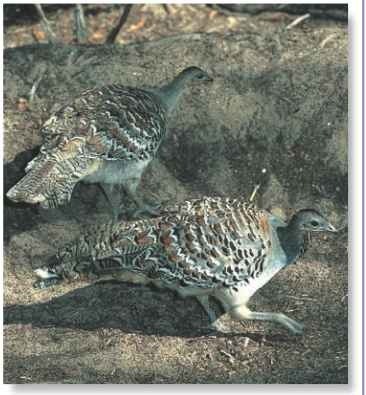
Conservation
The total population of malleefowl is now thought to be fewer than 10,000, following a dramatic decline in recent years. The greatest threat to the species is the destruction
of its habitat by wheat-growing and sheep-farming. Many eggs are taken by the introduced European fox and there is significant predation by feral cats.
PROFILE
Malleefowl
Specially adapted legs and feet enable the chicken-sized malleefowl to move huge amounts of soil and vegetation to construct nesting mounds.
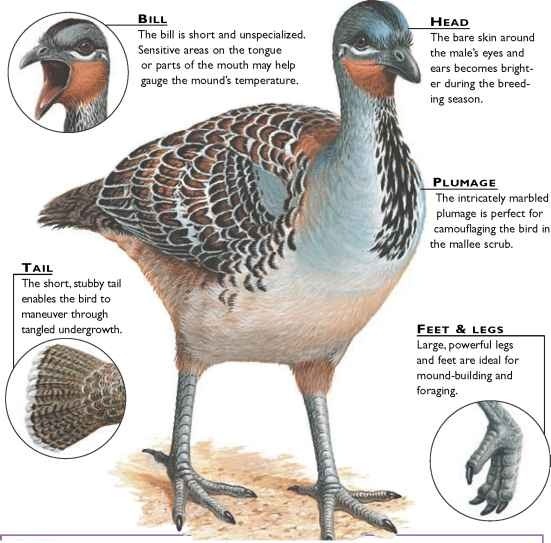
Creature comparisons
A close relative of the malleefowl, the maleo (Macrocephalon maleo) has a distinctive black, helmetlike knob on its crown; its purpose is unknown.The maleo is native to Sulawesi in Indonesia, and, like the malleefowl, eats both plant and animal food. Both species use naturally occurring heat to incubate their eggs. However, the maleo digs pits, not mounds, in which to lay eggs, often in soil warmed by volcanic activity. Like its mound building cousin, it uses the warmth of sun-exposed areas such as beaches, riverbanks and even dirt roads to-incubate its eggs.


| VITAL STATISTICS | |
| Weight | Male 5-6 lbs.; female 3-5 lbs. |
| Length | 24″ |
| Wingspan | 12-13.5″ |
| Sexual Maturity | Usually 4 years |
| Breeding Season | June-February |
| Number of Eggs | 15-24 |
| Incubation Period | 62-64 days average |
| Fledging Period | Independent on hatching |
| Breeding Interval | Annual but not during droughts or rainy periods |
| Typical Diet | Omnivorous, but mainly eats buds, flowers, fruits, seeds |
| Lifespan | Up to 25 years |
RELATED SPECIES
• The malleefowl -belongs to genus Leipoa, family Megapodiidae, a group of birds found almost exclusively in the Australasian region. There are 7 genera and 19 species within the family, the largest genus being Megapodius. The Megapodiidae are among the most distinctive members of order Galliformes, which contains 274 species including pheasants and curassows.
